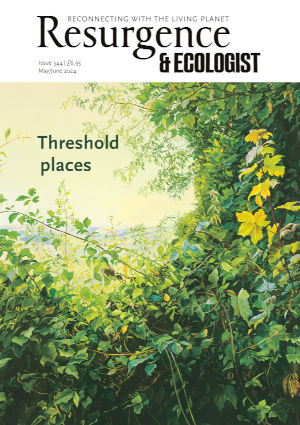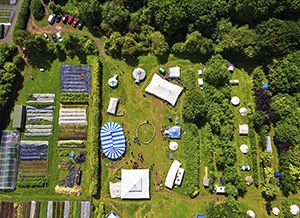Green & Away has now celebrated its ‘30-something’ birthday. By doing so, it has proved wrong the fundamental principle that governs many organisations, and indeed the economy as a whole – that to be successful, you have to continually get bigger.
Green & Away set up Europe’s first environmentally sound outdoor conference centre in 1991, and every year since has seen volunteers, interns and event participants attend our outdoor venue to learn about environmental issues in practice, and especially how to run a sustainable organisation.
In those 30-plus years, we have hosted companies, charities and campaigning groups, as well as individual celebrations. In essence, we set up a village for 150 people every summer and provide meals, meeting and leisure spaces, electricity, communications, water and bedrooms, all to a high environmental standard. We pack away the whole project at the end of each summer and leave the field just as we found it – rather the way we as a species should leave the planet.
Because we rely on groups booking events with us, and the team working on a voluntary basis, we also have to make the project attractive, comfortable, fun for the team, and financially viable.
Many companies – relying on the profit motive and wages – would envy the loyalty and commitment we create. Many charities would envy our financial viability. How do we do it?
Most organisations rely on getting bigger for their viability. They rely on the need for wages to ensure people turn up for work. They rely on discipline and punishment to keep slackers in line. And they rely on experienced (and older) leaders to keep the ship on an even keel. None of these are factors for Green & Away. Indeed, they are factors we have explicitly rejected over the years as being unhelpful to us.
We haven’t got bigger. We’ve experimented in doing so, but we decided the adverse effects were spoiling the organisation and could even endanger it. So we run events for about six weekends, for up to 150 people at a time. We keep our crew to a maximum of about 40. We are forever mindful that providing more facilities (‘a higher standard of living’) increases the workload. We’ve found that running a longer season tires us out, and increasing the number of participants strains the equipment, makes more work, and erodes the friendly atmosphere.
We are resolute in relying on people working voluntarily. We provide meals for our crew, and tents for those who need them. So our crew can work with us and leave without spending any money. As a charity we don’t make profits – our income is recirculated into equipment and support for our crew. This removes the tensions that arise from the leadership team being paid while others are not. (“How much is the CEO earning?”!!!) It also means everyone on the team really wants to be there.
I would argue too that Green & Away needs a much higher standard of management than a commercial company: if we manage our team badly, they can leave today. This is not a risk badly run companies face, so they take advantage of it.
And what about the leadership team? Most organisations seek experienced people as trustees or directors. They want specialists in management, or marketing, or finance, and this usually means people who are older – and often male, and often white. In the jargon: male, pale and stale.
We’ve adopted the practice of recruiting trustees from our interns, who are mostly university students. And we’ve changed our trustee body to now be dominated by people in their twenties. Some observers suggest they don’t have the experience necessary. I answer that very few people in their fifties and sixties (the average age of company directors) have the actual real experience to change their organisations to run in balance with the planet. Indeed, their desire to always make their company bigger is the opposite of the experience that is needed. But our trustees have the passion and the wisdom necessary, and, being in their twenties, will be personally affected by environmental degradation in a way that a 60-year-old won’t.
In our early years, I made the decision to make or buy all our equipment, rather than rely on hire companies. Owning everything, maintaining it, storing it and dealing with breakdowns undoubtedly adds to our work. But it means we can design everything to be as sustainable as possible, to be attractive and comfortable for our participants and, crucially, to increase the enjoyment of handling it for our crew (also not an issue of interest to most companies).
Also, it reduces our running costs. The result is that we are financially sustainable. This doesn’t just mean that we know we can finance every forthcoming season. It also means that our trustee meetings are devoted to discussing how we can make Green & Away better: more sustainable, more charming for participants, and more enjoyable for crew and trustees. We spend a tiny amount of our meeting time on the two big issues many (or most) organisations spend most of their time on: cutting costs and increasing profits.
Have we got it right for our participants and crew? Two comments last summer are worth passing on. One is from a former Syrian refugee on our crew (who booked in with us for a fortnight, and stayed much longer). He said his time at Green & Away was the best ever weeks of his life. Another comment, from the leader of one of Britain’s foremost national institutions: “You’ve really licked how you run this.”
Green & Away is now looking forward to our next 30 years. We will continue to provide intensive environmental education for our interns and crew, and an outdoor space where people can live closer to the natural world and see the impact our everyday living has on Nature. We don’t aim to get bigger. We hope to see you there.
The Resurgence summer camp will be held at Green & Away this year from 12 to 14 July. www.resurgence.org/summercamp








